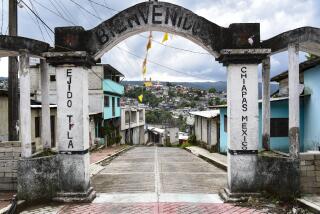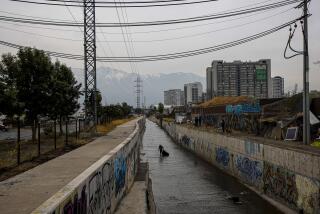Use of Land Mines Spreading in Colombia
- Share via
AQUITANIA, Colombia — The imperfectly healed stump that was once his left leg makes Luis Alfonso Quintero wince in pain, emotional as much as physical.
With a useless half-limb, how will he tend his emerald-green fields, or cross the village square without a care? How will he put food on the table for his seven kids, or dandle the youngest in his lap?
These were the simple things that defined the Quintero’s life until the day last year that a land mine exploded underneath him. For the 39-year-old farmer and father who can’t read or write, the blast destroyed more than flesh and bone.
“The most horrible thing is to be an invalid afterward,” Quintero said as he lay in a hospital bed, the white gauze on his leg discolored by an oozing infection. “At times I get very depressed looking at the future that awaits me.”
It’s a bleak prospect that haunts thousands of Colombians, victims of a civil war that has stretched into its fifth decade. As leftist rebels square off against right-wing paramilitaries and the Colombian army battles both, the use of land mines by militant groups has risen alarmingly in recent years.
So has the casualty count. In 2003, an average of two people a day -- both civilians and soldiers -- fell victim to mines and other unexploded ordnance across Colombia, an increase of more than five-fold from 2000.
Colombia ranked third for casualties in 2003, behind only Afghanistan and Cambodia, according to the International Campaign to Ban Landmines. Of the 668 casualties, 156 people died. From January through September 2004, 421 new casualties were registered, it said.
“We have to race to fix the problem,” said Alvaro Jimenez Millan, national coordinator of the Colombian Campaign Against Mines. “We’re the only [country] in the Americas where mines are being laid.”
He and other activists complain that the government has been slow to educate the populace, prioritize anti-mining efforts and help victims. Officials insist that they are taking action, with a national awareness project in the works and international aid in hand to help out.
Still, the situation is likely to worsen while the fighting drags on. Even if peace should come, experts say, the problem is expected to persist because removing mines could take years.
Almost every part of Colombia is affected. There are as many as 100,000 mines across the country, in half of Colombia’s 1,100 municipalities and in 30 of 32 states, officials and activists say. Only Guainia and the state of San Andres and Providencia, comprising two tiny islands in the Caribbean, are untouched.
Luis Alfonso Quintero’s village sits in Antioquia, the state that has been hit hardest. Getting to Aquitania, an outpost of 1,500 people on a strategic mountain ridge above beautiful, lush countryside, requires a 90-minute bone-jarring drive off the main highway along a rutted, winding dirt track.
For nine months last year, the residents lived under siege-like conditions, trapped after their fields and the road were sown with mines by leftist rebels of the Revolutionary Armed Forces of Colombia, or FARC.
Ordered to leave their farms, encircled by the threat of losing life or limb, residents huddled in the village square, subsisting on rice and beans brought in by aid agencies during brief spells when the army succeeded in de-mining the road. But rebels were quick to plant new ones.
When provisions ran out, desperation prompted some residents to risk returning to their fields. “At one point, we couldn’t even find a kilo of salt,” said Jose Ignacio Ramirez, 37, president of the town council.
That was how Quintero became Aquitania’s first civilian mine victim last June.
He was walking down a path he had taken the day before, headed out to harvest yucca, plantains and corn. Several others ambled on in front of him, but with a randomness that makes many residents here shake their heads, fate singled out Quintero.
“I remember it was a horrible pain,” he recalled. “I was bleeding everywhere, and when they came to help me, I was starting to pass out.”
It took hours for Quintero to be rescued from the trail because of the danger that there were more mines buried nearby. Eventually, he wound up in Medellin, the capital of Antioquia, where he has had multiple operations.
Quintero lost his lower left leg, and injuries to his right leg have required extensive treatment. It’s possible that he will never walk again.
“The defenseless are the ones who pay,” he said bitterly.
Aquitania has since suffered more casualties. One incident at the end of March hit three generations of the same family, including a 6-week-old baby. A man trod on a mine, and his daughter, carrying her baby, ran forward to help and stepped on another mine. Both adults lost part of their right legs; the child’s left leg and one lung were pierced by shrapnel.
Army soldiers are now posted in Aquitania, and their presence has helped keep the road open since December. But the situation remains perilous. At the end of April, the local commander said the military had removed 25 mines in and around the town that month. Mines have killed or wounded 30 to 40 soldiers in the region, he said.
Victims are entitled to government compensation, but it can be difficult to obtain. Most have to travel to their state capitals to make their claims, a journey often rendered impossible by their injuries or the expense.
Many of the maimed and crippled and the relatives of those who died are poor and illiterate, unable to fill out the necessary forms. Even when they can, critics say, the slightest error can cause their application to be thrown out and force them start over, putting them at risk of missing deadlines.
“We have a perfect law for assisting land mine victims,” said Jimenez Millan of the anti-mine campaign. “But the distance between the letter of the law and the application of the law is like that from here to China.”
Officials say they are doing their best. Three years ago, the government of President Alvaro Uribe opened an office dealing specifically with mines. With a budget of $1 million this year, director Luz Piedad Herrera and her staff are busy drafting national standards for anti-mine education and improving coordination of victim assistance.
Under an international anti-land mine convention signed by Colombia in 1997, the government has dismantled its own mine factory, begun destroying its stockpile and pledged to remove the mines planted by the army around 23 of its most important bases. But the treaty has no effect on the guerrilla and paramilitary groups.
Only the small, left-wing National Liberation Army has shown an interest in curtailing the use of mines. In January, it voluntarily cleared a nine-mile stretch of road in Bolivar state after reaching an agreement with community leaders. Activists hope that this will set a precedent for other ad hoc local de-mining initiatives. But the federal government officially frowns on such efforts, insisting that only it has the authority to negotiate with the armed groups.
There is little incentive for the combatants to give up homemade weapons that cost as little as $2 apiece and require minimal technical know-how to manufacture. The devices are often packed with everyday materials such as keys and nuts and bolts to maximize injury, and human waste to aggravate infection.
Four years ago, when Luis Alejandro Yepes was 8, both of his legs were amputated after he took a shortcut to a neighbor’s house, wandered off the path and detonated a mine.
Now, with his two stumps wrapped in olive-green Mickey Mouse socks, the boy scrambles up and down the stairs of his sister’s apartment in Medellin with remarkable ease, but he can’t play soccer like he used to. He’s been without prostheses for a month as he waits for new ones to fit his growing frame.
School can be fun -- although he says he’s “very bad at math” -- but Luis doesn’t like the way other kids sometimes look at him.
A quiet but relatively cheerful outward demeanor masks the agony he has had to endure, despair so deep that he tried at least twice to kill himself not long after the accident, said the national anti-mine campaign’s Medellin representative.
Jimenez Millan, the national coordinator, wants to prevent such tragedies by persuading militants to declare a humanitarian ban on land mines.
Neither the FARC nor the paramilitaries have responded to his organization’s requests to discuss the issue. But, Jimenez Millan said, “we’re not taking this as a no.”
“If the war has to go on, it has to go on,” he said. “But let’s come to an agreement on mines. An agreement on mines would lend some dignity to a conflict that is so undignified.”
*
(BEGIN TEXT OF INFOBOX)
Land mine victims
In 2003, Colombia had the third-highest rate of land mine casualties in the world.
The regions with the most land mine victims:
Afghanistan: 847
Cambodia: 772
Colombia: 668
Angola: 226
Chechnya: 218
Source: International Campaign to Ban Landmines
More to Read
Sign up for Essential California
The most important California stories and recommendations in your inbox every morning.
You may occasionally receive promotional content from the Los Angeles Times.











